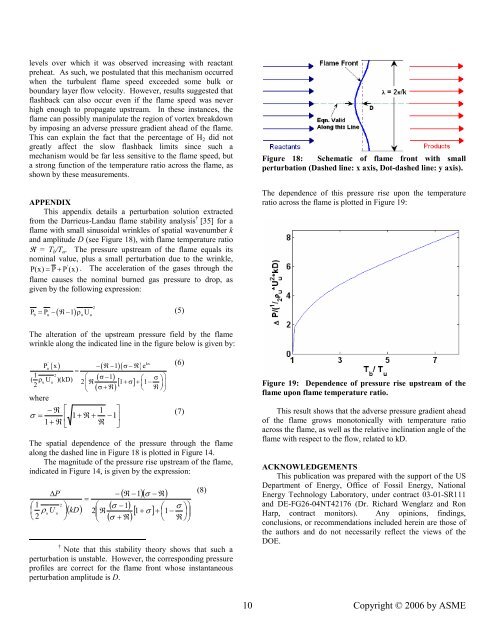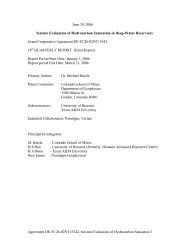levels over which it was observed increasing with reactant preheat. As such, we postulated that this mechanism occurred when the turbulent flame speed exceeded some bulk or boundary layer flow velocity. However, results suggested that flashback can also occur even if the flame speed was never high enough to propagate upstream. In these instances, the flame can possibly manipulate the region of vortex breakdown by imposing an adverse pressure gradient ahead of the flame. This can explain the fact that the percentage of H 2 did not greatly affect the slow flashback limits since such a mechanism would be far less sensitive to the flame speed, but a strong function of the temperature ratio across the flame, as shown by these measurements. APPENDIX This appendix details a perturbation solution extracted from the Darrieus-L<strong>and</strong>au flame stability analysis † [35] for a flame with small sinusoidal wrinkles of spatial wavenumber k <strong>and</strong> amplitude D (see Figure 18), with flame temperature ratio R = T b /T u . The pressure upstream of the flame equals its nominal value, plus a small perturbation due to the wrinkle, ' P(x) = P + P (x) . The acceleration of the gases through the flame causes the nominal burned gas pressure to drop, as given by the following expression: Figure 18: Schematic of flame front with small perturbation (Dashed line: x axis, Dot-dashed line: y axis). The dependence of this pressure rise upon the temperature ratio across the flame is plotted in Figure 19: 2 b = u − ( R − ) ρ (5) u u P P 1 U The alteration of the upstream pressure field by the flame wrinkle along the indicated line in the figure below is given by: ' u ( ) −( R − )( σ − R) 1 2 ( σ − 1) ( ) [ ] u u 2 ⎜ ⎝ σ + R where − R ⎡ 1 ⎤ σ = ⎢ 1+ R + −1⎥ 1+ R ⎣ R ⎦ kx P x 1 e = ( ρ U )(kD) ⎛ ⎛ σ ⎞⎞ 2 R 1+ σ + ⎜1− ⎟⎟ ⎝ R ⎠⎠ The spatial dependence of the pressure through the flame along the dashed line in Figure 18 is plotted in Figure 14. The magnitude of the pressure rise upstream of the flame, indicated in Figure 14, is given by the expression: (6) (7) − ( R −1)( σ − R) ( σ −1) ( ) [ ] ⎛ σ ⎞ ⎟ ⎞ 1 + σ + ⎜ − ⎟ σ + R R ⎠ ' ∆P = ⎛ ⎞ ⎛ ⎜ 1 ρ U 2 ⎟( kD) u u 2⎜R 1 ⎝ 2 ⎠ ⎝ ⎝ † Note that this stability theory shows that such a perturbation is unstable. However, the corresponding pressure profiles are correct for the flame front whose instantaneous perturbation amplitude is D. ⎠ (8) Figure 19: Dependence of pressure rise upstream of the flame upon flame temperature ratio. This result shows that the adverse pressure gradient ahead of the flame grows monotonically with temperature ratio across the flame, as well as the relative inclination angle of the flame with respect to the flow, related to kD. ACKNOWLEDGEMENTS This publication was prepared with the support of the US Department of Energy, Office of Fossil Energy, National Energy Technology Laboratory, under contract 03-01-SR111 <strong>and</strong> DE-FG26-04NT42176 (Dr. Richard Wenglarz <strong>and</strong> Ron Harp, contract monitors). Any opinions, findings, conclusions, or recommendations included herein are those of the authors <strong>and</strong> do not necessarily reflect the views of the DOE. 10 Copyright © 2006 by ASME
REFERENCES 1 Kroner, M., Fritz, J., Sattelmayer, T., “<strong>Flashback</strong> Limits for Combustion Induced Vortex Breakdown in a Swirl Burner,” ASME Paper # GT-2002-30075 2 Richards, G.A., McMillian, M.M., Gemmen, R.S., Rogers,W.A., <strong>and</strong> Cully,S.R., “Issues for Low-Emission, Fuel-Flexible Power System,” Prog. Energy Comb. Sci.,27, 2001, pp.141-169 3 Klimstra, Jacob, “Interchangeability of Gaseous Fuels – The Importance of the Wobbe Index,” SAE paper # 861578, 1986. 4 Moliere, M., “Benefiting from the Wide Fuel Capability of Gas Turbines: A Review of Application Opportunities,” ASME Paper # GT-2002-30017. 5 Durbin, M., Ballal, D., “Studies of Lean <strong>Blowout</strong> in a Step Swirl Combustor,” J. Engr. Gas Turbines <strong>and</strong> Power, Vol. 118, 1996. 6 Barlow, R.S., Fiechtner, G.J., Carter, C.D., Chen, J.Y., “Experiments on the Scalar Structure of Turbulent CO/H 2 /N 2 Jet Flames,” Comb. Flame, Vol. 120, 2000. 7 Correa, S.M., Gulati, A. “Non-premixed Turbulent CO/H 2 flames at local extinction conditions,” Proc. Comb. Inst. Vol. 22, 1988, pp. 599-606. 8 Drake, M.C., “Stretched Laminar Flamelet Analysis of Turbulent H2 <strong>and</strong> CO/H 2 /N 2 Diffusion Flames,” Proc. Comb. Inst., Vol. 21, 1986, pp. 1579-1589. 9 Correa, S.M., Gulati, A., Pope, S.B., “Assessment of a Partial Equilibrium/Monte Carlo Model for Turbulent <strong>Syngas</strong> Flames,” Comb. Flame, Vol. 72, 1988, pp. 159-173. 10 Masri, A. R., Dibble, R. W., “Spontaneous Raman Measurements in Turbulent CO/H 2 /N 2 Flames Near Extinction,” Proc. Comb. Inst. Vol. 22, 1988, pp. 607-618. 11 Maloney, D., “The Simulation Validation Project at NETL,” DOE Report, 2002. 12 Schefer, R. W., “Hydrogen Enrichment for Improved Lean Flame Stability,” International Journal of Hydrogen Energy, 28, 2003, pp. 1131-1141. 13 Wicksall, D., Agrawal, A., “<strong>Effects</strong> of Fuel <strong>Composition</strong> on Flammability Limit of a Lean, Premixed Combustor,” ASME Paper #2001-GT-0007 14 Zukoski, E.E., “Afterburners,” in Aerothermodynamics of Gas Turbine <strong>and</strong> Rocket Propulsion, G. Oates, Ed., 1997. 15 Spaulding, D., Some Fundamentals of Combustion, Ch. 5, Butterworth Press: London, 1955 16 Longwell, J., Frost, E., Weiss, M., “Flame Stability in Bluff-Body Recirculation Zones,” Ind. Eng. Chem., Vol. 45 (8), pp. 1629-1633. 17 Putnam, A., Jensen, R., “Appplication of Dimensionless Numbers to Flash-back <strong>and</strong> Other Combustion Phenomena,” Proc. Comb. Inst., 3rd, 1949, ,pp 89-98 18 Hoffmann, S., Habisreuther, P., Lenze, B., “Development <strong>and</strong> Assessment of Correlations for Predicting Stability Limits of Swirling Flames,” Chemical Engineering <strong>and</strong> Processing, 33 (1994), pp 393-400 19 Glassman, I., Combustion, Academic Press: New York, 1996. 20 Plee, S.L, Mellor, A.M., “Characteristic Time Correlation for Lean Blowoff of Bluff Body Stabilized Flames,” Comb. Flame, 35, 1979, pp. 61-80. 21 Radhakrishnan, K., Heywood, J., Tabaczynski, R., “Premixed Turbulent Flame Blowoff Velocity Correlation Based on Coherent Structures in Turbulent Flows,” Comb. Flame, 42, 1981, pp. 19-33. 22 Wohl, K., “Quenching, Flash-Back, Blow-Off Theory <strong>and</strong> Experiment,” 4th Symposium (Int.) on Combustion, 1952, pp. 69-89. 23 Putnam, A., <strong>and</strong> Jensen, R., “Application of Dimensionless Numbers to Flash-Back <strong>and</strong> Other Combustion Phenomena,” 3rd Symposium on Combustion, Flame, <strong>and</strong> Explosion Phenomena, 1948, pp. 89-98. 24 Plee, S. L., <strong>and</strong> Mellor, A. M., “Review of <strong>Flashback</strong> Reported in Prevaporizing/Premixing Combustors,” Combustion <strong>and</strong> Flame, Vol. 32, 1978, pp. 193-203. 25 Fritz, J., Kroner, M., <strong>and</strong> Sattelmayer, T., “<strong>Flashback</strong> in a Swirl Burner with Cylindrical Premixing Zone,” Proceedings of ASME Turbo Expo 2001, June 4-7, 2001. 26 Kroner, M., Fritz, J., <strong>and</strong> Sattelmayer, T., “<strong>Flashback</strong> Limits for Combustion Induced Vortex Breakdown in a Swirl Burner,” Proceedings of ASME Turbo Expo 2002, June 3-6, 2002. 27 Kiesewetter, F., Kirsch, C., Fritz, J., Kroner, M., <strong>and</strong> Sattelmayer, T., “Two-Dimensional <strong>Flashback</strong> Simulation in Strongly Swirling Flows,” Proceedings of ASME Turbo Expo 2003, June 16-19, 2003. 28 Thibaut, D., <strong>and</strong> C<strong>and</strong>el, S., “Numerical Study of Unsteady Turbulent Premixed Combustion: Application to <strong>Flashback</strong> Simulation,” Combustion <strong>and</strong> Flame, Vol. 113, 1998, pp. 53-65. 29 Davu, D., Franco, R., Choudhuri, A., Lewis, A., “Investigation on <strong>Flashback</strong> Propensity of <strong>Syngas</strong> Premixed Flames,” AIAA Paper # 2005-3585. 30 Lieuwen, T., Torres, H., Johnson, C., Daniel, B.R., Zinn, B.T., “A Mechanism for Combustion Instabilities in Lean Premixed Gas Turbine Combustors,” Journal of Engineering for Gas Turbines <strong>and</strong> Power, 123(1), 2001, pp. 182-190 31 Zhang, Q., Noble, D.R., Meyers, A., Xu, K., Lieuwen, T., “Characterization Of Fuel <strong>Composition</strong> <strong>Effects</strong> In H 2 /CO/CH 4 <strong>Mixture</strong>s <strong>Upon</strong> Lean <strong>Blowout</strong>,” ASME Paper # GT2005-689017 32 J. Natarajan, S. N<strong>and</strong>ula, T. Lieuwen <strong>and</strong> J. Seitzman, “Laminar Flame Speeds of Synthetic Gas Fuel <strong>Mixture</strong>s,” ASME Paper # GT2005-68917. 33 Kido, Hiroyuki, Nakahara, Masaya, “A Model of Turbulent Burning Velocity Taking the Preferential 11 Copyright © 2006 by ASME
















